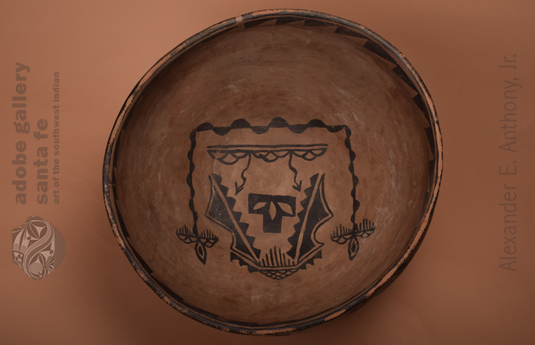Nineteenth Century Cochiti Pueblo Dough Bowl [R]
+ Add to my watchlist Forward to Friend
Forward to Friend
- Category: Historic
- Origin: Cochiti Pueblo, KO-TYIT
- Medium: clay, pigment
- Size: LARGE: 11” deep x 19” diameter
- Item # C4167A
- Price No Longer Available
It’s always exciting when a spectacular historic pottery vessel is brought to us for us to sell. We all stand around and admire it and discuss its size, age, condition and overall appearance and appeal. We obviously are looking at it from an artistic standpoint and its potential appeal to a collector.
There are other ways to view it than strictly as an object of art or as a functional item made for use in a pueblo household or made to be sold to a non-pueblo buyer.
An interesting way to truly appreciate a pottery item is to think of it from the perspective of the potter. As she and members of her family go to gather clay and haul it back home, she offers a prayer to Mother Earth for providing the clay. From that moment forward, she offers thanks for every step in the process of building the vessel. She is thankful if the pottery comes out of the firing in perfect condition. If it is damaged during the firing, she accepts it as that was meant to be. The outcome is always predetermined and not the fault of the potter.
Bowls are a special category that have significant meaning. Dr. Bruce Bernstein eloquently explains “the Pueblo world can be visualized as two bowls put together to form a sphere—the upper the Father or Sky and the lower the Mother or Earth.” Verzuh 2008:33
He continues “This perspective expands when you equate the bottom of the bowl with the bare yet fertile ground that constitutes a central pueblo plaza.”
If we follow those thoughts, then the interior of the bowl may represent the world of the pueblo people. Perhaps potters use the walls to express their view of that world. Every design has a meaning—sometimes ceremonial or religious and sometimes an expression of past history.
If we view a bowl, such as this large dough bowl, with an attempt to understand and appreciate the intent of the artist, it then becomes something more than a bowl for making bread and becomes a special bowl used for making bread. It may not be possible for us, as outsiders, to ever appreciate a bowl for what it really means to a pueblo person—something more than just a utilitarian object but an object made with meaning in the pueblo world.
This large dough bowl was made for use in working bread dough in preparation for making many loaves of oven bread. Large quantities of bread are made to be shared with family and friends during pueblo feast days. Hundreds of visitors are treated to meals in pueblo homes during those religious feast days. Meals are graciously shared and the plaza dances are for the benefit of all the world, not just the pueblo world.
This dough bowl is deep with relatively straight walls that roll in slightly and then roll out at the rim. This is quite typical of nineteenth-century dough bowls. The slip is rag-wiped bentonite that is traditional at Cochiti and Kewa Pueblos. Up to ten coats of slip may be applied to cover the basic clay body. This bentonite slip acts as a binder for the black vegetal pigment used for designs.
The exterior design was divided into up and down triangles within which are individual elements of black triangles and steps. A fringe of clouds is suspended from the framing line at the rim. The interior design is traditional Cochiti inspired. It is a cartouche of clouds, lightning and rain, very similar to many such designs used by Tonita Peña in her signature block on paintings. The black triangles near the rim are another form of clouds.
This dough bowl is exceptional both visually and historically. Late nineteenth century vessels from Cochiti are rare because most potters were producing figurines rather than bowls and jars. Those they purchased from their neighbor, Santo Domingo. It is rare to see a Cochiti dough bowl on the market.
Condition: this Nineteenth Century Cochiti Pueblo Dough Bowl is in very good condition with a few short rim cracks
Provenance: from a gentleman in Albuquerque
Reference: A River Apart: The Pottery of Cochiti & Santo Domingo Pueblos edited by Valerie K. Verzuh

- Category: Historic
- Origin: Cochiti Pueblo, KO-TYIT
- Medium: clay, pigment
- Size: LARGE: 11” deep x 19” diameter
- Item # C4167A
- Price No Longer Available



